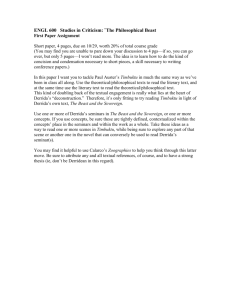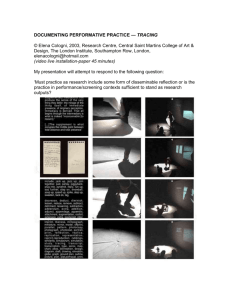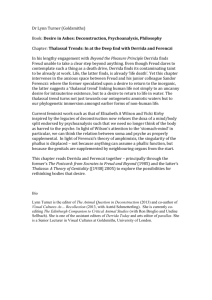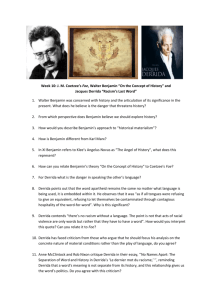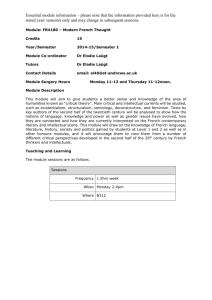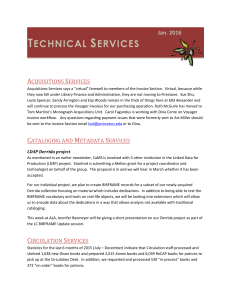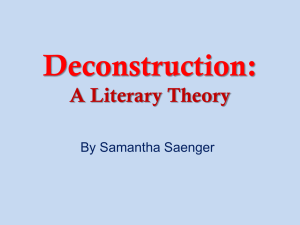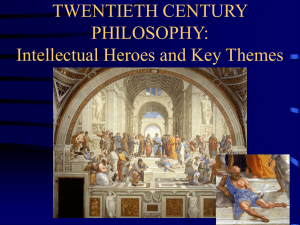Things Done With Words. Speech Act Theory and Deconstruction
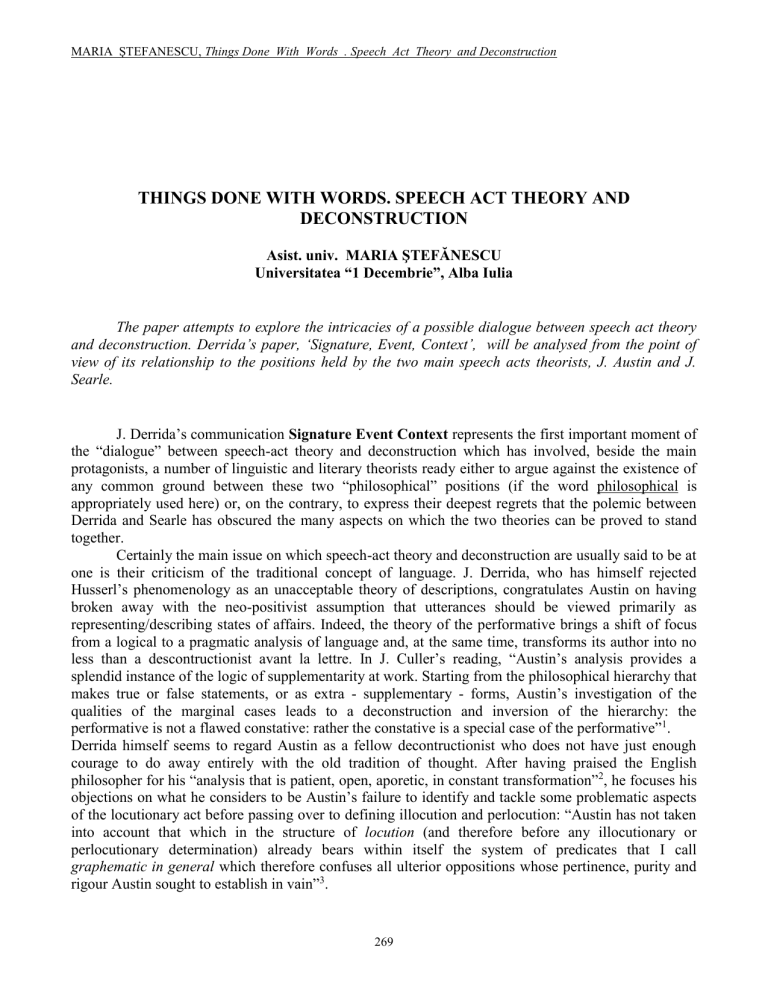
MARIA ŞTEFANESCU, Things Done With Words . Speech Act Theory and Deconstruction
THINGS DONE WITH WORDS. SPEECH ACT THEORY AND
DECONSTRUCTION
Asist. univ. MARIA ŞTEFĂNESCU
Universitatea “1 Decembrie”, Alba Iulia
The paper attempts to explore the intricacies of a possible dialogue between speech act theory and deconstruction. Derrida’s paper, ‘Signature, Event, Context’, will be analysed from the point of view of its relationship to the positions held by the two main speech acts theorists, J. Austin and J.
Searle.
J. Derrida’s communication
Signature Event Context represents the first important moment of the “dialogue” between speech-act theory and deconstruction which has involved, beside the main protagonists, a number of linguistic and literary theorists ready either to argue against the existence of any common ground between these two “philosophical” positions (if the word philosophical is appropriately used here) or, on the contrary, to express their deepest regrets that the polemic between
Derrida and Searle has obscured the many aspects on which the two theories can be proved to stand together.
Certainly the main issue on which speech-act theory and deconstruction are usually said to be at one is their criticism of the traditional concept of language. J. Derrida, who has himself rejected
Husserl’s phenomenology as an unacceptable theory of descriptions, congratulates Austin on having broken away with the neo-positivist assumption that utterances should be viewed primarily as representing/describing states of affairs. Indeed, the theory of the performative brings a shift of focus from a logical to a pragmatic analysis of language and, at the same time, transforms its author into no less than a descontructionist avant la lettre. In J. Culler’s reading, “Austin’s analysis provides a splendid instance of the logic of supplementarity at work. Starting from the philosophical hierarchy that makes true or false statements, or as extra - supplementary - forms, Austin’s investigation of the qualities of the marginal cases leads to a deconstruction and inversion of the hierarchy: the performative is not a flawed constative: rather the constative is a special case of the performative” 1
.
Derrida himself seems to regard Austin as a fellow decontructionist who does not have just enough courage to do away entirely with the old tradition of thought. After having praised the English philosopher for his “analysis that is patient, open, aporetic, in constant transformation” 2
, he focuses his objections on what he considers to be Austin’s failure to identify and tackle some problematic aspects of the locutionary act before passing over to defining illocution and perlocution: “Austin has not taken into account that which in the structure of locution (and therefore before any illocutionary or perlocutionary determination) already bears within itself the system of predicates that I call graphematic in general which therefore confuses all ulterior oppositions whose pertinence, purity and rigour Austin sought to establish in vain” 3
.
269
MARIA ŞTEFANESCU, Things Done With Words . Speech Act Theory and Deconstruction
Indeed, in How to Do Things with Words , all that one learns about the locutionary act is that
“it is roughly equivalent to uttering a certain sentence with a certain sense and reference” 4
. The possibility of grasping sentence-meaning is taken for granted and all efforts are directed towards identifying and giving a fairly comprehensive account of the conventionally-determined illocutionary force and its impact on utterance-meaning. Of course, such a position is untenable for Derrida who begins by casting doubt on Austin’s definition of convention as a socially-specific and historically constituted form of behaviour and goes on to say that the English philosopher fails to notice “a certain intrinsic conventionality of that which constitutes locution itself” 5 . Obviously, Derrida is too well acquainted with structuralist linguistics not to yield to the temptation of linking convention with the arbitrariness of sign and of relating them both to Saussure’s fundamental thesis that in language there are only differences, without positive terms. Moreover, his deconstructionist commitment does not allow him to accept what has been so far the structuralist compromise of saying that, indeed, meaning can only be defined in negative terms but the linguistic sign itself should be regarded as a positive entity. Ready to denounce the logocentric bias of such a solution, Derrida sticks to Saussure’s initial insight that language is made of differences and assumes further that all the objects and facts of our world are linguistically constituted or mediated. To put it in his own celebrated phrase, “There is nothing outside of the text [...]. In what one calls the real life of these existences of flesh and blood’ [...] there has never been anything but writing” 6
. Meaning itself becomes extremely problematic since it loses its stability and comes to be defined as a weave of pure traces, an endless play of differences and deferrals (Derrida even creates a new word, differance, to suggest this infinite regression and unchecked referral from signifier to signifier in a language now deprived of any “transcendental signified”).
At this point, the common ground between speech act theory and deconstruction is hardly visible: whereas for ordinary-language philosophers the success of human communication is axiomatic
(Austin seems to count on a natural expectation of meaning- fullness shared by the participants at speech so that for him the only question that should be answered is how, not why or if, language works), for Derrida even the theoretical possibility of communication is at the very least questionable and at the most utterly an illusion. When dealing with Austin’s felicity conditions he is struck precisely by their liability to failure and cannot understand why the English philosopher does not regard infelicities as an ever threatening risk: “the value of risk, or of being open to failure although it might, as Austin recognizes, affect the totality of conventional acts, is not examined as an essential predicate or law
” 7 . And, he asks rhetorically, “what is a success when the possibility of failure continues to constitute its structure ?” 8
. Of course, anyone could reply that, as it happens, people do communicate, a fact of which Derrida is perfectly aware since he concludes that “there are also performatives that succeed, and they must be accounted for [...]. And were a single one of them to have taken place a single time, it would still have to accounted for” 9 . Yet, with a most disconcerting “Perhaps.”, the
French philosopher simply dismisses his own challenge to modify his theory in order to do justice to such compelling empirical evidence as the existence of successful performatives.
Austin’s focus on social practices makes him highlight the notion of “context”. Illocutionary acts are said to gain their force from the interaction between a communicative intention and a set of socially validated conventions which provide specific contexts for each instance of speech. To understand how language works, one needs only look at the social practices it articulates since utterance-meaning will be, in most cases, precisely the result of such a communicative interaction.
Derrida’s critique of this position amounts to an undermining of the idea that an utterance’s meaning could be exhaustively grasped by reconstructing the context of its production. For the French philosopher, as for any deconstructionist reader, Austin’s account of the notion of context proves to be trapped within the narrow confines of logocentric discourse. Derrida is eager to show how utterly
270
MARIA ŞTEFANESCU, Things Done With Words . Speech Act Theory and Deconstruction untenable Austin’s premise is: the very idea of an absolutely determinable context is utopic because the conditions for its existence cannot be met (if one wants to avoid “metaphysical idealizations”, he cannot hope to find “a free consciousness present for the totality of the operation, [nor] an absolutely full meaning that is master of itself: the teleological jurisdiction of a total field whose intention remains the organizing center” 10 . Whereas on the Austinian picture subjective intentions go for very little, they are extremely important with Searle and J. Culler will focus his criticism precisely on this aspect. He has learnt Freud’s lesson as well as Derrida’s and he cannot possibly trust the ideas of self-presence or consciousness or self-identity or self-possession or even self- proximity. Consequently, he rejects on psychoanalytical grounds Searle’s claim that, in the case of promises, “the thing promised must be something the hearer wants done or considers to be in his interest
” 11
. If, Culler argues, unconscious desire becomes a contextual consideration, the speaker/hearer will be at a loss to find out what he really and most truly wants. As to the notion of meaning defined as a signifying intention present to consciousness at the moment of utterance, both Culler and Derrida are ready to denounce it as one of the most unfortunate fetishes of European philosophical tradition.
Before discussing in more details another aspect of Derrida’s critique, concerning this time an allegedly reified opposition between speech and writing, I would like to point out to R. Rorty’s objection to one of the most important deconstructionist targets - the distinction between the essential and the marginal - because it seems to me it touches the point at issue: “the fact that two contrasting terms get their meaning by reciprocal definability, and in that sense presuppose each other, does nothing to cast doubt on their utility. Nor would such doubt be cast by showing [...] that the ‘upper’ term can be seen as a ‘special case’ of the ‘lower’ term. Practically everything can be seen, with a bit of imagination and contrivance, as a special case of practically anything else [...]. But such ingenuity is in vain if it has no purpose more special than ‘escaping from logocentrism” 12
. It is well-known how the equation central - marginal works in the case of Derrida’s discussion of the status of writing. Rejecting the traditional treatment of writing - as an epiphenomenon, a mere abbreviation of speech - the French philosopher argues that, on the contrary, speech should actually be viewed as a from of writing and that both terms should be subsumed to a rather vaguely defined originary / non-originary proto-writing. To try to privilege speech over writing, as Derrida thinks Austin does in How to Do Things with Words , means to be committed to the logocentric premise that spoken words, unlike written discourse, do not obstruct the faithful and complete transmission of meaning. Yet, it might be that Derrida makes too big an issue of the English philosopher’s exclusion of written texts from his analysis. It is true that Austin claims to have confined himself, “for simplicity, to spoken utterances” but this is not always the case and does not amount to a very careful picking out of each and every piece of written discourse. On the contrary, when he attempts to prove that what determines the successful performance of a speech act is social convention rather than authorial intention, Austin points to the example of somebody who makes a will (i.e. a written document) but who, after he dies, has no means whatsoever of securing the fulfillment of his wishes if the legislation or the social practices of his country change.
Undoubtedly the most controversial and problematic aspect of speech act theory, Austin’s labelling of literature as “parasitic” on ordinary language, provides Derrida with a new opportunity to expose what he believes to be the English philosopher’s inability to really break away with logocentric thinking. The doctrine of the “etiolations of language” is regarded as just another instance of a familiar relationship of supplementarity: the non - serious uses of language are something marginal, added to
“normal” talk and wholly dependent upon it. In principle, any scholar is perfectly right to ask for a justification of this exclusion but the focus of Derrida’s critique seems to be somehow misplaced. He appears to assume on rather unclear grounds, that Austin denies the very possibility of iteration in language: “In question, precisely, is the possibility that every performative utterance (and a priori every other utterance) may be ‘cited’. Now, Austin excludes this eventuality (and the general doctrine which
271
MARIA ŞTEFANESCU, Things Done With Words . Speech Act Theory and Deconstruction would account for it) with a kind of lateral persistence, all the more significant in its off-sidedness. He insists upon the fact that this possibility remains abnormal, parasitical ” 13 . And, again, “is not what
Austin excludes as anomalous, exceptional, ‘non-serious’, that is citations (in the stage, in a poem or in a soliloquy) the determined modification of a general citationality - or rather a general iterability - without which there would not even be a ‘successful’ performative ?” 14 . Derrida’s objection would be justified if it did not start from a wrong (or, at least, hard to prove) assumption. Austin could not have possibly failed to notice and acknowledge the presence of the phenomenon of citationality in language, when his paramount interest - the social conventions that validate speech acts - have as part of their basic mechanism a certain iterability of stock formulas. But what is actually at stake here will not become clear until one remembers that for Derrida citationality has nothing to do with some innocent recurrence of fixed expressions but represents the general and inescapable condition of any discourse.
All signs, linguistic and non-linguistic alike, have a necessarily iterable existence; thereby they “can break with every given context and engender infinitely new contexts, in an absolutely nonsaturable fashion” 15
; (emphasis added). Because the unity of any signifiying from is given only by its iterability
(which implies the possibility of being repeated in the absence of both its signified and its referent), meaning itself, endlessly deferred, is perceived as always already a transcription.
In the opening section of Signature Event Context Derrida claims that the “impasses” of
Austin’s theory are rooted in his inability to recognize the graphematic nature of all signifying forms.
As a matter of fact, it would take another deconstructionist to recognize that much, but what is extremely interesting about this communication is that two position which, in my opinion, are irreconcilable, come to appear as almost complementary due to a very surprising “concession” made by
Derrida: “above all, I will not conclude [...] that there is no relative specificity of the effect of consciousness, of the effects of speech (in apposition to writing in the traditional sense), that there is no effect of the performative, no effect of ordinary language, no effect of presence and of speech acts” 16
.
But the existence of these effects and the necessity for them to be studied is all that speech act theory has ever claimed!
Notes:
1. J. Culler, On Deconstruction. Theory and Criticism after Structuralism , Routledge, London, 1989, p. 113
2. J. Derrida, Margins of Philosophy , translated with additional notes by Alan Bass, The University of Chicago Press,
Chicago, 1982, p. 322
3. ibid.
4. J. L. Austin, How to Do Things with Words , Harvard University Press, Cambridge, Massachusetts, 1975, 2 nd edition, p. 103
5. J. Derrida, op. cit., p. 323
6. apud. Readrawing the Lines. Analythic Philosophy, Deconstruction and Literary Theory , Ed. Reed Way
Dasenbrock, University of Minnesota Press, Mineapolis, 1989, p. 150
7. J. Derrida, op. cit. p. 324
8. ibid.
9. ibid., p. 326
10. ibid., p. 323
11. Searle, John R. , Speeach Acts. An Essay in the Philosophy of Language , Cambridge University Press, Cambridge,
1977, p. 59
12. apud. Redrawing the Lines ...
, p. 208
13. J. Derrida, op. cit., p. 324
14. ibid., p. 325
15. ibid., p. 320
16. ibid., p. 327
272
